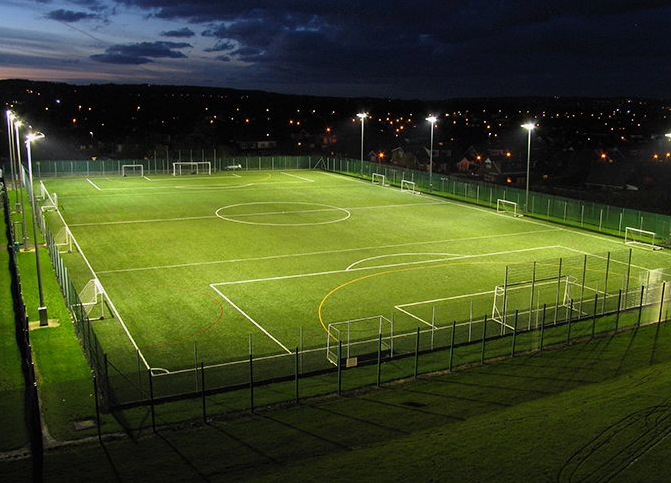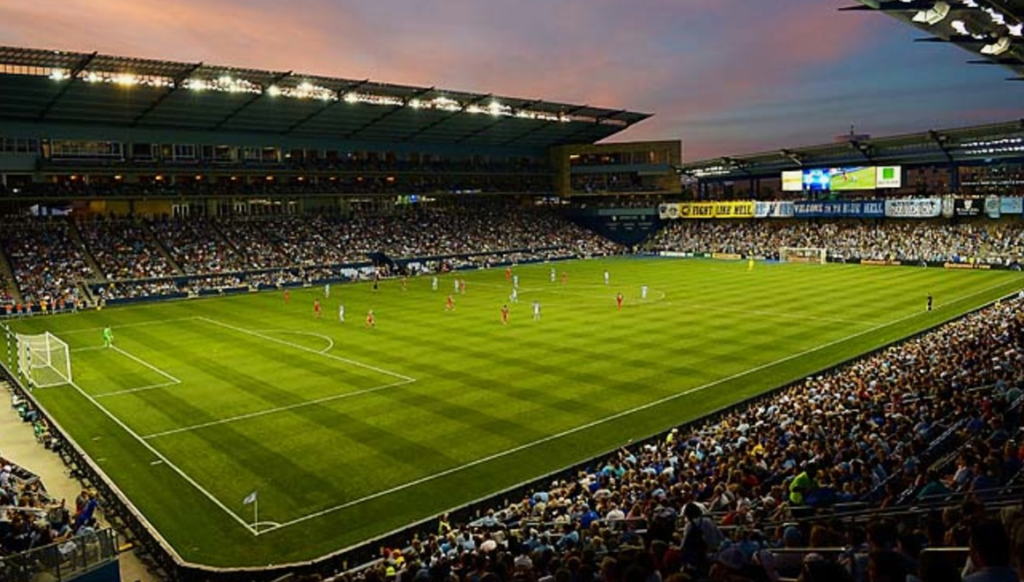The standard MLS soccer field dimensions are approximately 120 yards in length and 75 yards in width. These measurements are in line with international soccer field standards, providing ample space for players to showcase their skills and tactics on the pitch. MLS teams compete on these regulation-sized fields, ensuring fair and consistent gameplay across all matches. Soccer enthusiasts often seek information on MLS field dimensions to better understand the sport’s dynamics and strategies employed by teams. The precise measurements of the soccer field play a crucial role in shaping the flow of the game, influencing player positioning, passing accuracy, and goal-scoring opportunities.
By adhering to specific field dimensions, MLS matches maintain a level playing field for all teams, enhancing the competitiveness and excitement of each game.
MLS Soccer Field Dimensions

Regulation Field Size- MLS Soccer Field Dimensions
The regulation field size for MLS soccer is crucial for ensuring fair play and strategic gameplay. Understanding the specific dimensions and layout of the field is essential for players, coaches, and fans alike. Let’s delve into the specifics of MLS soccer field dimensions, focusing on the length and width specifications, as well as the goal size and placement.
Length And Width Specifications- MLS Soccer Field Dimensions
The MLS regulation soccer field has specific length and width requirements. According to official regulations, the field must measure approximately 110 to 120 yards in length and 70 to 80 yards in width. These dimensions provide the necessary space for players to showcase their skills while maintaining a level playing field.
Goal Size And Placement
Goals are integral to the game of soccer, and their size and placement are carefully defined in MLS regulations. The goal width should measure 8 yards, while the goal height must be 8 feet. Additionally, the goals are positioned at the center of each goal line, ensuring uniformity across all MLS fields.
Variations In Field Dimensions
MLS soccer fields are known for their variations in dimensions, which can have a significant impact on the gameplay. Understanding the differences in field sizes across MLS stadiums and their impact on the game is crucial for players, coaches, and fans alike.
Differences In Field Sizes Across Mls Stadiums
MLS stadiums vary in field dimensions, with lengths typically ranging from 110 to 120 yards and widths from 70 to 80 yards. For example, the field at Mercedes-Benz Stadium in Atlanta measures 115 by 75 yards, while the Yankee Stadium in New York has a smaller field of 110 by 70 yards.
Impact on Gameplay
The variations in field sizes can directly impact the gameplay, affecting the style of play and strategies employed by teams. A larger field allows for more open play and encourages a possession-based game, while a smaller field may lead to a more compact and direct style of play, emphasizing quick transitions and tight defensive formations.
Historical Evolution
The field dimensions of Major League Soccer (MLS) have undergone various changes over the years, reflecting the evolution of the game and its strategic demands. Understanding the historical evolution of MLS soccer field dimensions provides valuable insights into the sport’s development and the factors influencing these changes.
Changes In Field Dimensions Over Time
The evolution of MLS soccer field dimensions has been a dynamic process, with alterations occurring to enhance the game’s tactical and technical aspects. Comparing the MLS pitch size vs premier league and FIFA soccer field dimensions, it is evident that MLS has adapted its field dimensions to align with international standards while also catering to the unique characteristics of the league.
Reasons Behind Alterations
- Strategic Considerations: Changes in field dimensions were made to optimize tactical gameplay, create scoring opportunities, and facilitate dynamic player movements.
- Player Safety: Alterations aimed to enhance player safety and reduce the risk of injuries, aligning with the league’s commitment to the well-being of its athletes.
- International Standards: MLS field dimensions were adjusted to comply with international soccer standards, ensuring consistency and compatibility with global competitions.
- Fan Experience: Field dimension alterations were also influenced by considerations for fan engagement, providing an immersive and exciting environment for spectators.
In summary, the historical evolution of MLS soccer field dimensions reflects a strategic approach to aligning with international standards, prioritizing player safety, and enhancing the overall soccer experience for both athletes and fans. These changes have contributed to the evolution of MLS as a prominent soccer league with competitive and captivating gameplay.
Player Perspective
The size of the soccer field can have a significant impact on player performance. Players need to adjust their strategy and tactics based on the dimensions of the field they are playing on. In this section, we will discuss the effect of field size on player performance and strategies for different field sizes.
Effect of Field Size on Player Performance
The size of the field affects the speed and style of play. A larger field means more running and fewer chances to score. A smaller field means less running and more opportunities to score. Players need to adapt their game based on the size of the field they are playing on.
On a larger field, players need to focus on maintaining possession and controlling the pace of the game. They need to be patient and look for opportunities to make precise passes and create scoring chances. Defensively, players need to be organized and maintain their shape to prevent the opposition from exploiting the space.
On a smaller field, players need to be more direct and take advantage of the limited space. They need to make quick passes and move the ball up the field as fast as possible. Defensively, players need to be more aggressive and press the opposition to force turnovers and create scoring opportunities.

Strategies For Different Field Sizes
Coaches need to adjust their strategies based on the size of the field they are playing on. Here are some general strategies for different field sizes:
| Field Size | Strategy |
|---|---|
| Large | Control possession, be patient, look for scoring opportunities, maintain shape defensively |
| Medium | Maintain possession, be patient, look for scoring opportunities, press defensively |
| Small | Direct play, quick passes, move the ball up the field, press aggressively defensively |
Coaches also need to consider the strengths and weaknesses of their team when deciding on a strategy. For example, if a team has fast players, they may want to play on a larger field to take advantage of their speed. If a team has strong defenders, they may want to play on a smaller field to make it harder for the opposition to break through.
Technological Advancements
The technological advancements in soccer field dimensions have revolutionized the game. MLS soccer field dimensions are meticulously designed to meet the tactical requirements of the sport, providing players with an optimal playing space. These advancements not only enhance the game but also contribute to the overall experience for both players and fans.
Role of Technology In Maintaining Field Dimensions
Maintaining accurate field dimensions is crucial in the game of soccer. In the past, maintaining the dimensions of the soccer field was a manual task, where the groundsmen had to use measuring tapes and strings to ensure the field was up to standard. However, with the advent of technology, maintaining the field dimensions has become easier and more efficient.
Innovations In Field Measurement
One of the technological advancements that have revolutionized field measurement is the use of GPS technology. This technology has enabled groundsmen to accurately measure the field’s dimensions, ensuring that it adheres to the standard measurements. GPS technology provides an accurate and cost-effective way of measuring the field’s dimensions, reducing the time it takes to measure the field manually. Another innovation in field measurement is the use of drones. Drones equipped with cameras and sensors can provide a detailed view of the field and help groundsmen detect any unevenness or deviations in the field’s dimensions.
Future Trends
The future trends in MLS soccer field dimensions are constantly evolving to adapt to modern soccer trends. As the sport continues to progress, there are potential changes in MLS field dimensions and a focus on adapting to modern soccer trends.
Potential Changes In MLS Field Dimensions
MLS field size has always been a topic of discussion, especially in comparison to FIFA soccer field dimensions. There is a possibility of potential changes in MLS field dimensions to align more closely with international standards. This could involve increasing the size of the field to match the dimensions set by FIFA, providing players with a larger playing area and enhancing the overall quality of the game.

Adapting To Modern Soccer Trends
Adapting to modern soccer trends is crucial for the development of the sport. MLS is likely to consider adjusting field dimensions to accommodate the evolving tactics and strategies used in the modern game. This could involve creating more space on the field to encourage a faster and more dynamic style of play, aligning with the soccer field size in feet that is favored in many international leagues.
Frequently Asked Questions
What is the size of the MLS field?
The MLS field size is approximately 70 yards wide and 110 yards long.
What is the biggest pitch in the MLS?
The biggest pitch in the MLS is 120 yards by 75 yards in size.
What are the dimensions of the World Cup soccer field?
The World Cup soccer field dimensions are approximately 100-110 meters in length and 64-75 meters in width.
What is the average MLS soccer stadium size?
The average MLS soccer stadium size is approximately 20,000 to 30,000 seats. It varies based on specific stadium designs.
Conclusion
Discovering the optimal MLS soccer field dimensions is key to enhancing gameplay and strategy. Understanding field sizes impacts player performance and overall match dynamics. By grasping these dimensions, teams can maximize their potential on the pitch. Stay informed to excel in MLS soccer matches.

